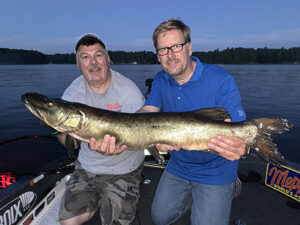By Steve Heiting
If you have fished muskies for any length of time, you must admit you are always listening for whispers about the proverbial “Lake X,” a secret, out-of-the-way fishing spot the public has overlooked. In our dreams Lake X is filled with big muskies that see little or no fishing pressure.
I’m sorry to stick a pin in your balloon of hope, but Lake X simply doesn’t exist in this day of the Internet and social media. I find it remarkable (and a bit sad) that every water I have ever fished or thought of fishing for muskies — even tiny, 40-acre potholes — has been discussed somewhere on the Internet.

Last winter I read of a study in which 59 percent of anglers surveyed admitted to learning of a fishing spot via the Internet or social media, and I think that number is probably a bit low. Consider that the social media “friends” list of every established musky guide is packed with “snipers” whose only reason for following said guide is to glean information from the photos they post.
Fishing pressure is a fact of life everywhere muskies are found. Musky fishing has grown in popularity over the last quarter century, and because of magazines, books, television and the Internet, today’s musky hunter is better than those of the past. But there are ways to succeed in the face of this pressure, and following are five ways I do it.
1. Fish Differently Than Others — If you fish the same spots with the same methods as everyone else on the lake, you’re leaving your odds of success to chance. When you encounter other musky boats on the same water, closely observe what they’re doing. Often you’ll have to fish shallower or deeper than the rest. For example, in Wisconsin the inside weed edge and extremely deep, “open” water, are overlooked. Most cheesehead musky anglers like to be on the weed edge or drifting over weedbeds. Another way to fish differently is to upsize or downsize your lures to something different than others are casting. You can also change the style you’re using. If conditions call for jerkbaits and other fishermen are pitching dive-and-rise style baits like Suicks, switch to gliders like Phantoms.
2. Fish At Different Times — Very few musky anglers (including me) will rise at the crack of dawn. Water-skiers and jet skiis won’t be there, either, making the time period even better. Later in the day, lakes become much less crowded after sunset. If you must fish during the day, know that many musky anglers take a break at lunch or dinner, or for a nap during the afternoon. Moonrise, moonset, moon overhead and moon underfoot occur at different times each day, and it’s wise to postpone any breaks you had planned and fish through the moon event. Not only will you often see fewer fishermen, but you’ll probably catch more fish per week. Consider scheduling trips to destination waters for non-peak months. Prime time for tourists is from Father’s Day weekend until a week or so before kids go back to school. Book your trips before or after this two-month window and the water will be quieter. A final way to fish at different times is to stick it out in adverse weather conditions, like a heavy rainstorm.
3. Fish Where Others Aren’t — For years fishing writers have droned that the way to avoid fishing pressure is to fish “secondary spots” which are overlooked by others. In my view, the reason they are secondary and get overlooked is they usually aren’t as good as the lake’s spots, so I really don’t consider this good advice. The overlooked spots I seek really aren’t that secondary. If a musky follows my bait or I catch one, I immediately begin to look around for every nearby point, fallen tree, weed patch or other irregularity that could hold a fish. Baitfish are the reason the first musky was located where it was is, so any nearby spot — no matter how tiny — that could possibly provide cover to a fish needs to be checked. Another tip is what I call “waiting them out.” If I motor to a region of a destination water and find others already there, or launch my boat on a lake and find most of the rigs at the landing are owned by musky fishermen, I grin and bear it. Eventually, others seem to tire of the pressure and leave, and often I end up having the area or lake to myself.
4. Tournament Considerations — There is much to be learned from tournament anglers about fishing pressure, and one of the greatest ideas to consider is “camping” on a spot. The practice involves fishing a single spot all day that you know is holding muskies, and waiting until a feeding window opens. Although boring, it’s a pretty good idea. When tournaments are in progress, non-tournament fishermen tend to avoid such waters in the belief the lake is being “pounded to death.” In reality, muskies have no idea a tournament is going on, and fish feed during non-tournament hours. When I guided, one of my favorite tricks was to launch my boat as soon as tournament hours ended for the day. Often my clients and I had the water to ourselves.
5. Be Better — Possibly the best way to become a better musky fisherman is to learn to work with your partner to figure out patterns as they develop. Talk about every variable you encounter and choose your baits not according to the criteria of favorites or hope, but with the purpose of narrowing down the pattern.
Once you have location, timing, lure type, speed and color pinned down, muskies will be caught. Blaming fishing pressure for lack of success is nothing more than making an excuse. Muskies feed every single day and it’s your goal as a fisherman to figure out how to get them to bite.
